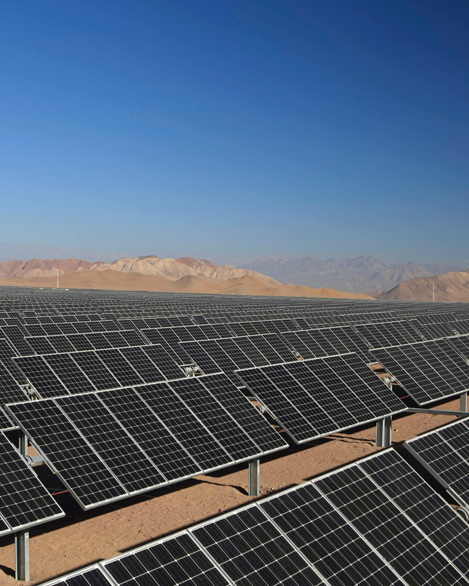CAP promotes energy conservation by its efficient use and by implementing clean technologies beginning at the design stage of any new project or business. Each of the companies of the Group has a strategy to approach energy efficiency and business opportunities generated by climate change.

The Paris Agreement (AP, in its Spanish acronym) was rendered legal in 2016, and Chile set in motion its 2050 Energy Strategy. Both these milestones will have significant repercussions in the way that progress is to be made on climate change issues.
In order to move toward a country with a more sustainable and inclusive energy sector, Chile defined its path through an Energy Strategy that established goals and commitments by the year 2050 and 2035. Some of the goals requiring the most direct commitment on the part of the companies are:
Climate change poses a problem of increasing importance to Chile. GHG emissions (GEI, in its Spanish acronym) have continued to grow hand-in-hand with economic growth and international organizations projected that they will continue an upward course. According to global climate change studies, the country is vulnerable to climate change effects such as: floods, extreme heat and reduced availability of water, among others.

The energy management systems of companies seek to make more efficient the amount of energy consumed per unit produced. In order to support this goal, an energy efficiency diagnosis was carried out this year to the entire Group. Based on this study, reduction plans were designed to be managed by each company. An example of the foregoing is CAP Acero, which is implementing and projecting several improvement initiatives, such as: testing of new metallurgical coal mixtures, changing the coal mixture at the Coke Plant, change of lighting luminaries for more efficient ones, among other initiatives. On the other hand, Cintac has focused on including improvements into its galvanized steel plant; such as for example, substituting its gas boiler.
In addition to CAP Mineria’s two work sites that already have energy efficiency certification (Planta Magnetita and Mina Los Colorados), in 2016 work was carried out in certifying the Pellets Plant and Cerro Negro Norte work sites. On the other hand, CAP Acero made progress in implementing an Energy Management System based on such standard. This process identified those areas with higher energy consumption (both thermal and electrical) in order to subsequently focus on making significant consumptions more efficient.
Although the Group’s energy consumption increased from 25,511,256 GJ in 2015 to 25,836,642 GJ in 2016, this was partly attributable to the fact that the values reported in 2015 by Cintac and Infraestructura do not include fuel consumption. Electric energy, on the other hand, dropped during the same period from 4,210,902 GJ in 2015 to 3,888,971 GJ in 2016 because of the implementation of adequate reduction plans in the two business units with greater consumption: CAP Mineria and CAP Acero. At CAP Acero its greater efficiency in electric energy consumption was reinforced with the creation of a company Energy Management Committee in 2016 comprised of professionals from various company areas. This instance, highly valued, has three objectives: (a) advise management on energy issues; (b) analyze energy consumption in the different areas, as well as propose and compile proposals or savings ideas; and, (c) ensure the follow-up of ongoing activities.
ENERGY CONSUMPTION TABLE |
Minería |
Acero |
Procesamiento7 |
Infraestructura8 |
||||||||
|---|---|---|---|---|---|---|---|---|---|---|---|---|
|
2014 |
2015 |
2016 |
2014 |
2015 |
2016 |
2014 |
2015 |
2016 |
2014 |
2015 |
2016 |
GJoules of total energy consumed |
5,072,701 |
6,809,900 |
6,378,775 |
19,431,651 |
18,407,535 |
19,093,761 |
64,850 |
33,660 |
68,751 |
117,720 |
260,161 |
295,355 |
GJoules of electricity consumed |
2,271,024 |
2,583,238 |
2,240,312 |
1,222,801 |
1,333,843 |
1,322,881 |
24,462 |
33,660 |
34,229 |
117,720 |
260,161 |
291,549 |
GJoules of electricity consumed / ton produced |
0.18 |
0.17 |
0.14 |
1.81 |
1.72 |
1.62 |
0.20 |
0.16 |
0.19 |
0.01 |
0.01 |
0.01 |
GJoules of fuel consumed |
2,801,677 |
4,226,662 |
4.138.463 |
18,208,850 |
17,073,692 |
17,770,880 |
40,388 |
n.i. |
34,522 |
n.i. |
n.i. |
3,806 |
7The processing figures only include Cintac, not TUPEMESA or TASA. The 2015 total energy figure only includes electrical energy consumption.
8The infrastructure figures only include the desalination plant. The 2014 and 2015 total energy figures only include electrical energy consumption.

The CAP Group seeks to contribute to Chile’s adaptation to climate change, encouraging the consumption of non-conventional renewable energy (NCRE), by promoting energy efficiency and developing new businesses based on the opportunities presented by this phenomenon.
Efforts to incorporate NCRE have been part of the management of all the companies of the group. CAP Mineria, for example, in 2014 incorporated solar energy into the processes of Cerro Negro Norte. On the other hand, in 2016 CAP Acero managed to get 35% of its electricity from NCRE.
The companies measure their carbon footprint periodically. In the case of CAP Acero, it reports its performance annually to the World Steel Association. In 2016, Cintac measured its carbon footprint for the first time, evidencing that the greatest CO2 equivalent came from Cintac Maipu; with Scope 2 being the most relevant in the aspects of electricity purchases. In order to reduce the footprint, one of the initiatives implemented by Cintac consisted in replacing a substance called 141b for cyclo-pentane (ciclo pentano) in the manufacturing of insulated PUR* panels. With this, the company contributed to the country’s goal of reducing these emissions by 8%; a goal committed in the Montreal Protocol of the Vienna Convention for the Protection of the Ozone Layer.
*PUR - Spanish acronym for: Rigid Foam Polyurethane Panel.
deslice
| Acero9 | Procesamiento10 | |||||
|---|---|---|---|---|---|---|
| 2014 | 2015 | 2016 | 2014 | 2015 | 2016 | |
| Scope 1- Tonnes of CO2 equivalent | Not measured | Not measured | 1,547 | |||
| Scope 2- Tonnes of CO2 equivalent | 2,822 | |||||
| Scope 3- Tonnes of CO2 equivalent | 341,945 | |||||
| Intensity of emissions - Tonnes of CO2 equivalent / ton produced | 3.0 | 2.2 | 2.1 | 5,975 | ||
9The carbon footprint at CAP Acero is estimated according to the methodology of the World Steel Association.
10Cintac’s carbon footprint was first measured this year.
Scope 1: Direct emissions from the production process.
Scope 2: Indirect emissions from purchased energy consumption.
Scope 3: Indirect emissions from related third-party activities.
CINTAC is building the largest solar plant on roofs of the Southern Cone, on the roof of 90 thousand square meters of its own facilities in Santiago. The energy complex has a total power capacity of 8 MW, equivalent to the annual electricity consumption of 5,000 5-member households. With this plant annual cost savings are expected of up to 50% of the entire network consumption.
Cintac Solar has become the company’s gateway into the electric generation business by means of solar energy. This solution is now being marketed to different industries around the country, thus contributing to a reduction of the carbon footprint along with the benefit of energy efficiency savings.